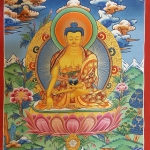32 Physical characteristics of the Buddha
Buddha attained parinirvana almost two thousand and five hundred years ago. Those who lived during the era of the Dharma’s end did not have the opportunity to see his golden face and physical characteristics up close.
The main characteristics that were visible at first glance and the secondary characteristics invisible but which aroused in every man sympathy and the pleasure. It is mentioned in the canonical texts that Buddha has thirty-two main characteristics and eighty secondary characteristics.
The thirty-two main characteristics are as follows:
- Flat soles, no arch
- Thousand Spoke Wheel Mark Underfoot
- Thin and long fingers, white as snow
- Flexible arms and legs
- Finely webbed toes and fingers
- Full Heels
- Feet of equal thickness, full length
- Flesh as fine and soft as that of the royal deer
- Dangling arms, hands fall lower than arms. knees
- Well retracted male organ
- Arm height and stretch, equal
- Dark hairiness
- Graceful and Curly Body Hair
- Golden color body
- Ten foot aura body
- Soft and smooth skin
- Well-rounded feet, hands, shoulders and skull
- Full Armpits
- Dignified and majestic bearing
- Straight body
- Full and rounded shoulders
- Forty Teeth
- White and jointed teeth
- Regular and equal teeth
- Cheeks full like a lion’s
- Saliva improves the taste of all foods
- Long and Wide Tongue
- Deep and sonorous voice
- Eyes of dark color and crystal clear like the sea
- Extraordinary eyelashes
- Light radiating between the eyebrows
- Fleshy protuberance on the top of the head.
It is said in the sutras:
“It takes a hundred kalpas to cultivate the physical characteristics and three ásañkhya to perfect merits and wisdom “.
The thirty-two physical characteristics of Buddha are not innate, but due to the practice of ninety-one kalpas.
According to the Adornment by Hundred Happiness Sutra, one must practice a hundred happiness’s to acquire a physical characteristic, and even that of the tongue, long and wide, requires an accumulation billions of times of “without lying”, in order to be acquired.
Thus, to learn Buddhism, one must diligently cultivate merits and wisdom, to obtain accomplished fruits.










